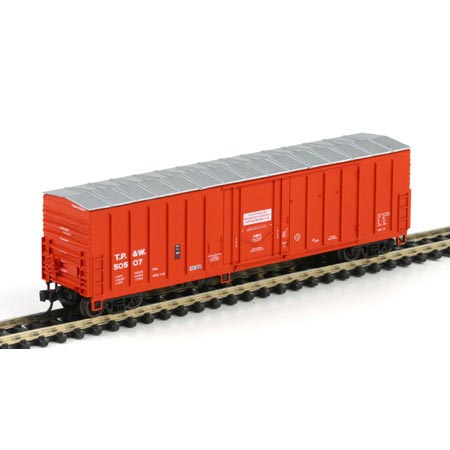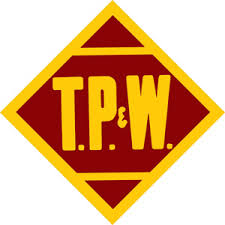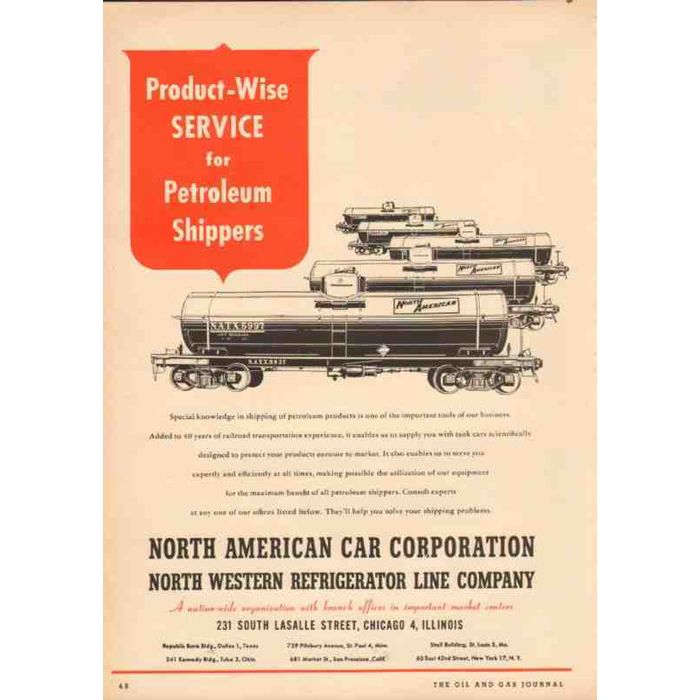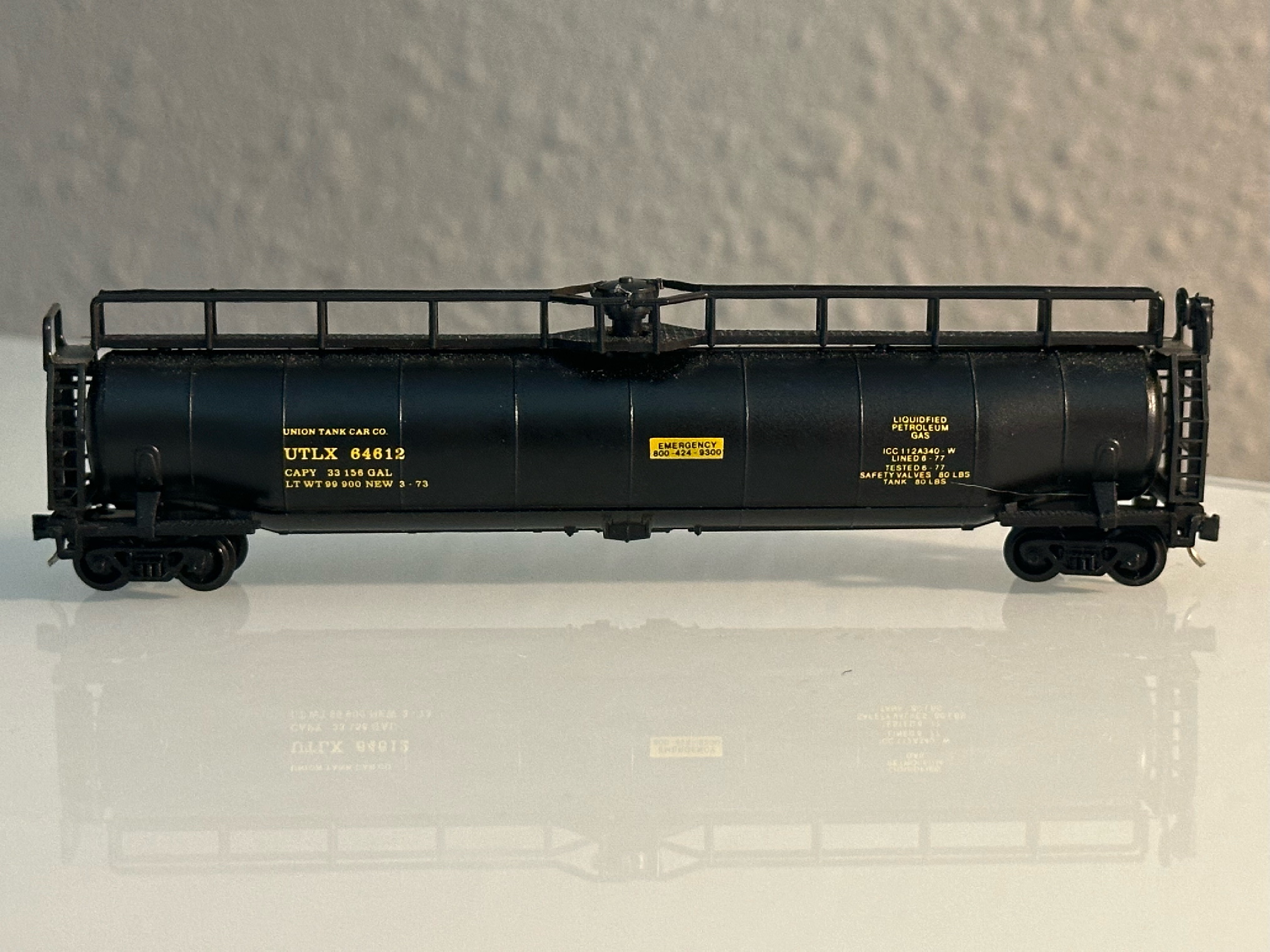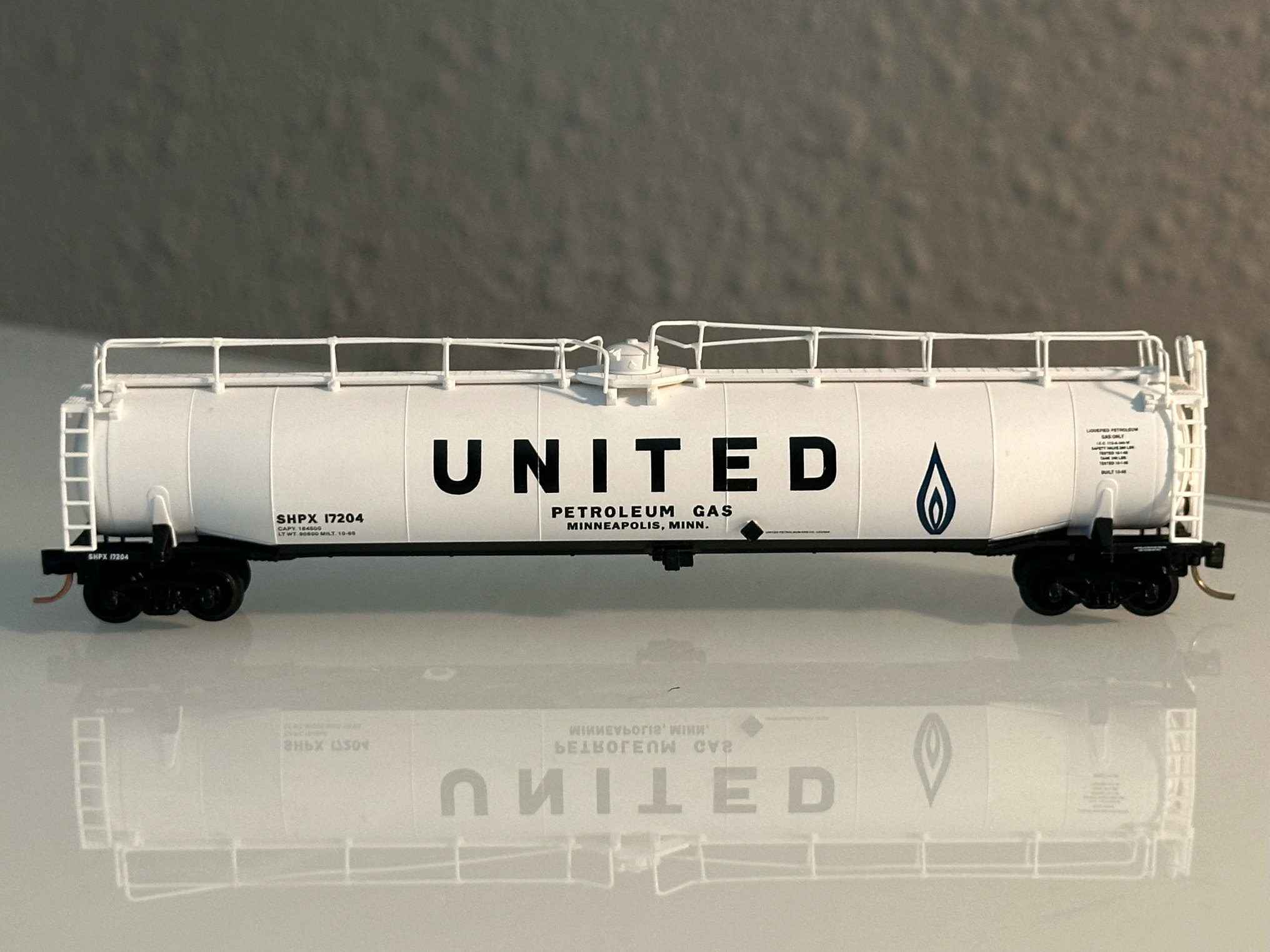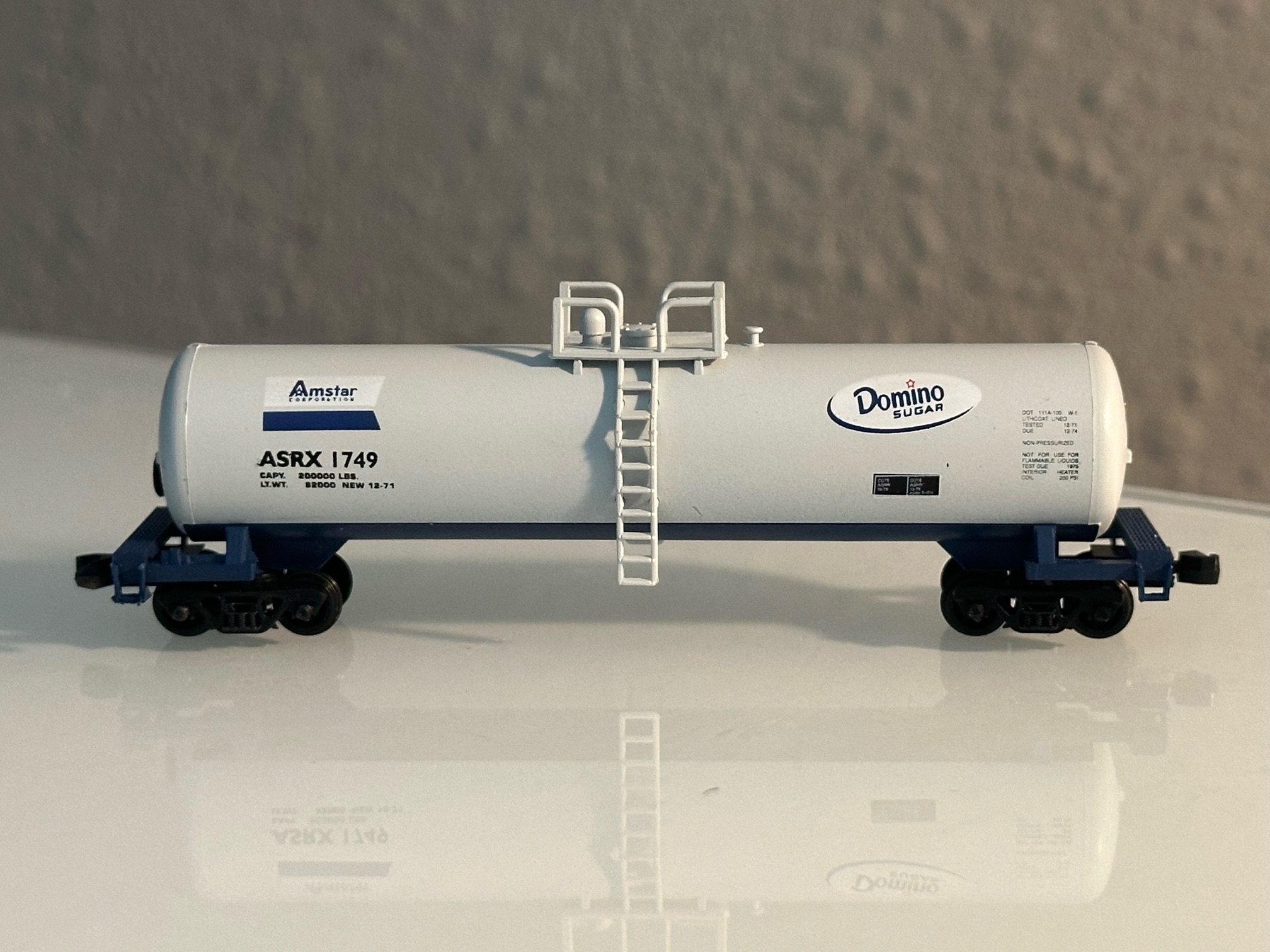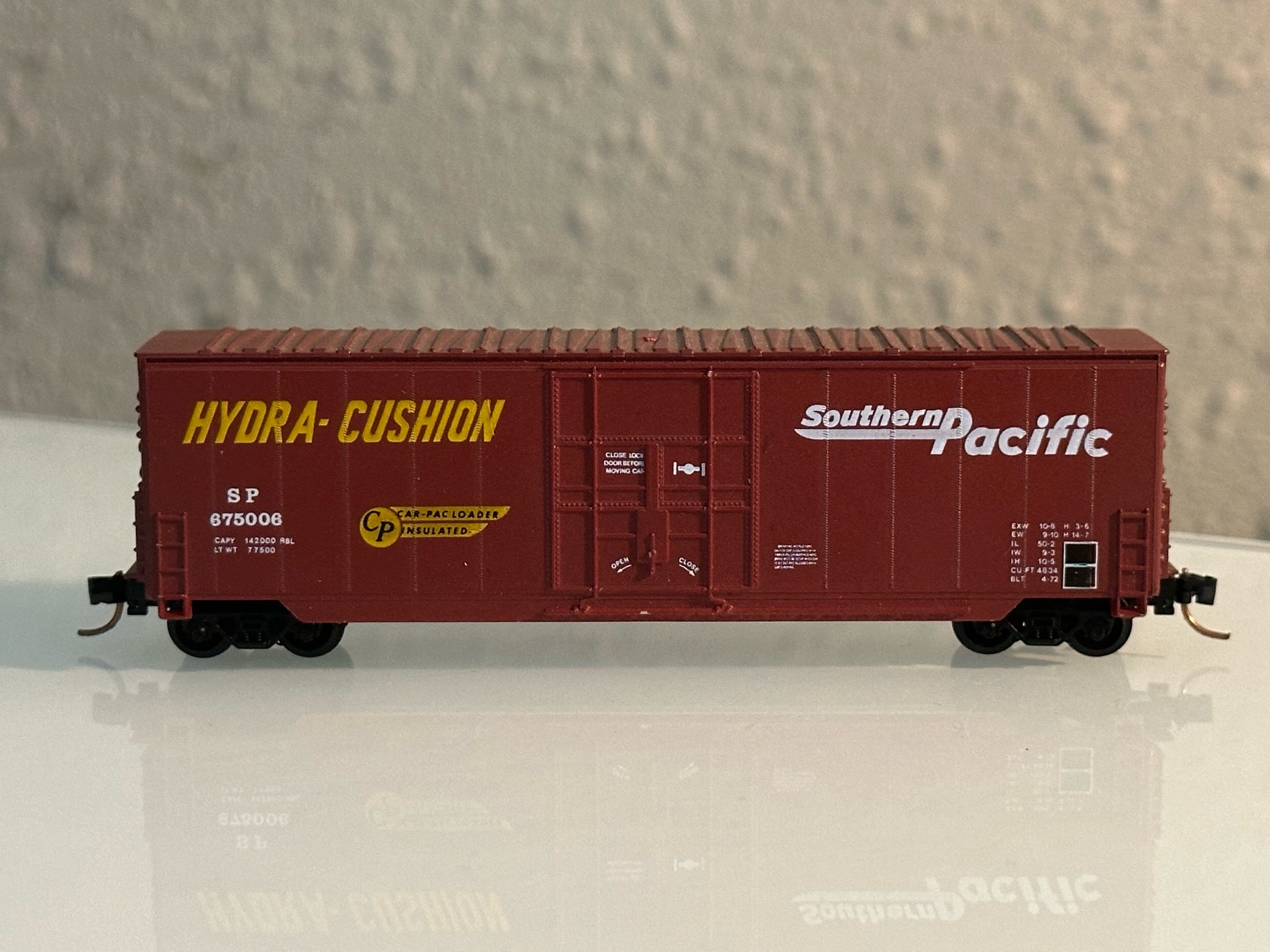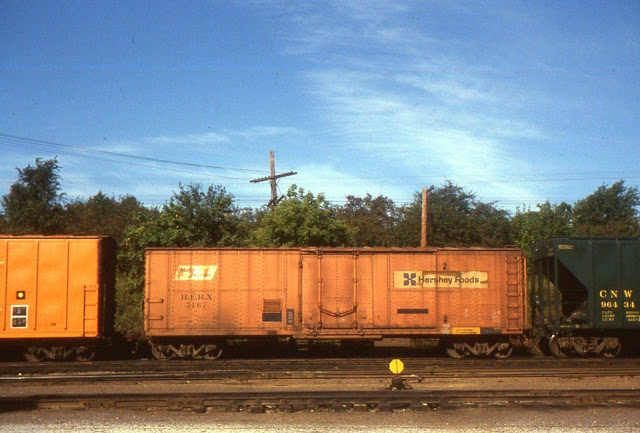Model Information: MODEL FEATURES:
- Three road numbers
- Etched metal stirrup steps
- Fully-assembled and ready-to-run out of the box
- Accurately painted and printed
- Highly detailed, injection molded body
- Detailed, molded underframe
- Weighted for trouble free operation
- N-scale 70 ton trucks with machined 33" metal wheels operate on all popular brands of track
- Body mounted McHenry operating scale knuckle couplers
- Clear plastic jewel box for convenient storage
- Minimum radius: 9"
- Three road numbers
- Etched metal stirrup steps
- Fully-assembled and ready-to-run out of the box
- Accurately painted and printed
- Highly detailed, injection molded body
- Detailed, molded underframe
- Weighted for trouble free operation
- N-scale 70 ton trucks with machined 33" metal wheels operate on all popular brands of track
- Body mounted McHenry operating scale knuckle couplers
- Clear plastic jewel box for convenient storage
- Minimum radius: 9"
Prototype History: The 50’ NACC boxcar was designed and built by the North American Car Corporation (NACC) in the early 1960s. The car was an insulated boxcar equipped with a plug-door. Insulated cars are used to carry various commodities that are temperature sensitive. The plug door offers better sealing of the car to maintain temperature and better protection from weather, theft, and other possible damages.
North American Car built the 50600-50624 series in 1965, and the 50625-50674 in May, 1966 for lease to the Rio Grande. These exterior post cars were assembled by North American using Stanray roofs and ends, Keystone cushioned underframes, 10 foot Superior plug doors, and either Euipco or Evans load divider bulkheads and side fillers. The 50600-50624 had Morton perforated running boards but the 50625-50674 were built without roof walks and full-height side ladders which were to be banned beginning January 1, 1967. Both series used Wabcopac truck mounted brake cylinders and the livery was modified to delete the silver paint below the black stripe. The 50638 was assigned for loading on the New York Central (which was shown in the picture) These cars were returned to North American by 1972 and were replaced by more modern reefers with the same numbers.
North American Car built the 50600-50624 series in 1965, and the 50625-50674 in May, 1966 for lease to the Rio Grande. These exterior post cars were assembled by North American using Stanray roofs and ends, Keystone cushioned underframes, 10 foot Superior plug doors, and either Euipco or Evans load divider bulkheads and side fillers. The 50600-50624 had Morton perforated running boards but the 50625-50674 were built without roof walks and full-height side ladders which were to be banned beginning January 1, 1967. Both series used Wabcopac truck mounted brake cylinders and the livery was modified to delete the silver paint below the black stripe. The 50638 was assigned for loading on the New York Central (which was shown in the picture) These cars were returned to North American by 1972 and were replaced by more modern reefers with the same numbers.
Road Name History: TP&W first appeared under that name in 1887. For most of its history, the TP&W ran east and west from Peoria, Illinois, to Keokuk, Iowa on the west bank of the Mississippi River on one end and Effner just on the other side of the Illinois-Indiana state line. There were a couple of short branches on the west end of the line.
TP&W first attracted national attention in 1887 when a passenger excursion train wrecked in Chatsworth, Illinois. The double headed train originated in Peoria and was packed with excursionists headed for Niagara Falls (via connections.) The train was running at speed when it approached a low trestle that had been weakened by a prairie fire. The trestle was only about 15’ high. The lead locomotive made it across and the second engine plunged through it, bringing the train of wooden coaches to an instant halt. At least one of the coaches was telescoped by another. 85 were killed and hundreds injured.
In 1941, TP&W backed out of national labor negotiations over a pay increase that was being considered. TP&W instead pushed for hourly wages and loosening of work rule restrictions. The unions struck and with the outbreak of war, operations were taken over by the Federal Government. After the war, the government handed the operation back to the owner George McNear and the labor strike resumed. In 1947 McNear was assassinated by a striker and that was that. The railroad was sold and operation resumed.
In addition to the local traffic they generated across central Illinois, TP&W served as a bridge route between the Santa Fe at Lomax, Illinois near the west end and the Pennsylvania at Effner, Indiana on the east end. Santa Fe and Pennsy’s only direct connection was in Chicago with all of Chicago’s inherent congestion. Many traffic managers preferred to route through Peoria. For Santa Fe and Pennsylvania, that meant routing over the TP&W.
In the steam era, the kings of the TP&W were a group of six 4-8-4 Northerns purchased in 1937. These Alco’s were the smallest 4-8-4’s on the continent. The diesel era was dominated by Alco and EMD road switchers with a splash of F’s and Lima-Hamilton switchers (these were later replaced by SW1500’s.)
In 1960, the Minneapolis & St. Louis attempted to gain control of the TP&W as well as Monon. M&St.L was also a funnel for the Peoria Gateway and thought the TP&W a good addition. However, when Santa Fe and Pennsy got wind of M&St.L’s stock purchases, the Santa Fe put out their own buy order and quickly grabbed control away from M&St.L. Santa Fe then sold a 50% stake in the TP&W to the Pennsylvania.
In 1970, TP&W suffered a wreck in Crescent City, Illinois. A string of propane tank cars was involved. One of the cars caught fire. As it burned, it boiled the propane in the adjacent car. Eventually the pressure of the boiling fuel exceeded the strength of the fire weakened shell of the tank and it exploded. The cycle started again with the next car. The fire department had successfully evacuated Crescent City but was powerless to fight the fire as burning propane rained down on the town. Crescent City was all but destroyed and the accident led the FRA to set standards on track quality with power to embargo traffic from lines that fell below certain maintenance levels.
The creation of Conrail in 1976 changed traffic patterns for the TP&W. Bridge traffic to the Santa Fe began to dry up. TP&W bought the ex-PRR line from Effner to Logansport, Indiana and a new connection to N&W was established. This brought the TP&W mileage to just over 300 making it about the size of Ann Arbor.
In 1979 the corporate successor of Penn Central sold their half of the TP&W to Santa Fe. At the end of 1983, TP&W was merged into the Santa Fe. In 1986, 33 miles of former TP&W line toward the west end were sold to Keokuk Junction Rwy. But the story didn’t end there.
In 1989, the TP&W lines were spun off by Santa Fe to a group of investors and the TP&W was reborn. The 1995 BNSF merger brought trackage rights for TP&W over the former CB&Q from Peoria northwest to Galesburg. A year later, TP&W was purchased by Delaware Otsego Corporation who also owned the New York Susquehanna & Western and a few shortlines in the New York – Pennsylvania – New Jersey area. During DO ownership, a typical day saw 165 cars move on the line. In 1999, the RailAmerica shortline group made an offer for the TP&W that DO couldn’t refuse and that September, the sale was closed. In 2004, the lines west of Peoria were sold to Keokuk Junction with TP&W continuing with the routes east. In 2012, all of the RailAmerica roads, TP&W included, joined the Genesee & Wyoming shortline group.
TP&W first attracted national attention in 1887 when a passenger excursion train wrecked in Chatsworth, Illinois. The double headed train originated in Peoria and was packed with excursionists headed for Niagara Falls (via connections.) The train was running at speed when it approached a low trestle that had been weakened by a prairie fire. The trestle was only about 15’ high. The lead locomotive made it across and the second engine plunged through it, bringing the train of wooden coaches to an instant halt. At least one of the coaches was telescoped by another. 85 were killed and hundreds injured.
In 1941, TP&W backed out of national labor negotiations over a pay increase that was being considered. TP&W instead pushed for hourly wages and loosening of work rule restrictions. The unions struck and with the outbreak of war, operations were taken over by the Federal Government. After the war, the government handed the operation back to the owner George McNear and the labor strike resumed. In 1947 McNear was assassinated by a striker and that was that. The railroad was sold and operation resumed.
In addition to the local traffic they generated across central Illinois, TP&W served as a bridge route between the Santa Fe at Lomax, Illinois near the west end and the Pennsylvania at Effner, Indiana on the east end. Santa Fe and Pennsy’s only direct connection was in Chicago with all of Chicago’s inherent congestion. Many traffic managers preferred to route through Peoria. For Santa Fe and Pennsylvania, that meant routing over the TP&W.
In the steam era, the kings of the TP&W were a group of six 4-8-4 Northerns purchased in 1937. These Alco’s were the smallest 4-8-4’s on the continent. The diesel era was dominated by Alco and EMD road switchers with a splash of F’s and Lima-Hamilton switchers (these were later replaced by SW1500’s.)
In 1960, the Minneapolis & St. Louis attempted to gain control of the TP&W as well as Monon. M&St.L was also a funnel for the Peoria Gateway and thought the TP&W a good addition. However, when Santa Fe and Pennsy got wind of M&St.L’s stock purchases, the Santa Fe put out their own buy order and quickly grabbed control away from M&St.L. Santa Fe then sold a 50% stake in the TP&W to the Pennsylvania.
In 1970, TP&W suffered a wreck in Crescent City, Illinois. A string of propane tank cars was involved. One of the cars caught fire. As it burned, it boiled the propane in the adjacent car. Eventually the pressure of the boiling fuel exceeded the strength of the fire weakened shell of the tank and it exploded. The cycle started again with the next car. The fire department had successfully evacuated Crescent City but was powerless to fight the fire as burning propane rained down on the town. Crescent City was all but destroyed and the accident led the FRA to set standards on track quality with power to embargo traffic from lines that fell below certain maintenance levels.
The creation of Conrail in 1976 changed traffic patterns for the TP&W. Bridge traffic to the Santa Fe began to dry up. TP&W bought the ex-PRR line from Effner to Logansport, Indiana and a new connection to N&W was established. This brought the TP&W mileage to just over 300 making it about the size of Ann Arbor.
In 1979 the corporate successor of Penn Central sold their half of the TP&W to Santa Fe. At the end of 1983, TP&W was merged into the Santa Fe. In 1986, 33 miles of former TP&W line toward the west end were sold to Keokuk Junction Rwy. But the story didn’t end there.
In 1989, the TP&W lines were spun off by Santa Fe to a group of investors and the TP&W was reborn. The 1995 BNSF merger brought trackage rights for TP&W over the former CB&Q from Peoria northwest to Galesburg. A year later, TP&W was purchased by Delaware Otsego Corporation who also owned the New York Susquehanna & Western and a few shortlines in the New York – Pennsylvania – New Jersey area. During DO ownership, a typical day saw 165 cars move on the line. In 1999, the RailAmerica shortline group made an offer for the TP&W that DO couldn’t refuse and that September, the sale was closed. In 2004, the lines west of Peoria were sold to Keokuk Junction with TP&W continuing with the routes east. In 2012, all of the RailAmerica roads, TP&W included, joined the Genesee & Wyoming shortline group.
Brand/Importer Information: Athearn's history began in 1938, when its founder-to-be, Irvin Athearn, started an elaborate O scale layout in his mother's house. After placing an ad selling the layout, and receiving much response to it, Irv decided that selling model railroads would be a good living. He sold train products out of his mother's house through most of the 1940s. After becoming a full-time retailer in 1946, Irv opened a separate facility in Hawthorne, California in 1948, and that same year he branched into HO scale models for the first time.
Athearn acquired the Globe Models product line and improved upon it, introducing a comprehensive array of locomotive, passenger and freight car models. Improvements included all-wheel drive and electrical contact. One innovation was the "Hi-Fi" drive mechanism, employing small rubber bands to transfer motion from the motor spindle to the axles. Another was the double-ended ring magnet motor, which permitted easy connection to all-wheel-drive assemblies. Athearn was also able to incorporate flywheels into double-ended drives.
The company produced a model of the Boston & Maine P4 class Pacific steam locomotive which incorporated a cast zinc alloy base and thermoplastic resin superstructure. It had a worm drive and all power pickup was through the bipolar trucks that carried the tender. This item was discontinued after the Wilson motor was no longer available, and was not redesigned for a more technologically advanced motor.
Athearn's car fleet included shorter-than-scale interpretations of passenger cars of Southern Pacific and Atchison, Topeka & Santa Fe Railroad prototypes. The company also offered a variety of scale-length freight cars with sprung and equalized trucks. The cars could be obtained in simple kit form, or ready-to-run in windowed display boxes. The comprehensive scope of the product line contributed to the popularity of HO as a model railroad scale, due to the ready availability of items and their low cost.
Irv Athearn died in 1991. New owners took control in 1994, but continued to follow Athearn's commitment to high-quality products at reasonable prices. Athearn was bought in 2004 by Horizon Hobby. Athearn was then moved from its facility in Compton to a new facility in Carson, California. In mid-2009, all remaining US production was moved to China and warehousing moved to parent Horizon Hobby. Sales and product development was relocated to a smaller facility in Long Beach, California.
Read more on Wikipedia and Athearn website.
Athearn acquired the Globe Models product line and improved upon it, introducing a comprehensive array of locomotive, passenger and freight car models. Improvements included all-wheel drive and electrical contact. One innovation was the "Hi-Fi" drive mechanism, employing small rubber bands to transfer motion from the motor spindle to the axles. Another was the double-ended ring magnet motor, which permitted easy connection to all-wheel-drive assemblies. Athearn was also able to incorporate flywheels into double-ended drives.
The company produced a model of the Boston & Maine P4 class Pacific steam locomotive which incorporated a cast zinc alloy base and thermoplastic resin superstructure. It had a worm drive and all power pickup was through the bipolar trucks that carried the tender. This item was discontinued after the Wilson motor was no longer available, and was not redesigned for a more technologically advanced motor.
Athearn's car fleet included shorter-than-scale interpretations of passenger cars of Southern Pacific and Atchison, Topeka & Santa Fe Railroad prototypes. The company also offered a variety of scale-length freight cars with sprung and equalized trucks. The cars could be obtained in simple kit form, or ready-to-run in windowed display boxes. The comprehensive scope of the product line contributed to the popularity of HO as a model railroad scale, due to the ready availability of items and their low cost.
Irv Athearn died in 1991. New owners took control in 1994, but continued to follow Athearn's commitment to high-quality products at reasonable prices. Athearn was bought in 2004 by Horizon Hobby. Athearn was then moved from its facility in Compton to a new facility in Carson, California. In mid-2009, all remaining US production was moved to China and warehousing moved to parent Horizon Hobby. Sales and product development was relocated to a smaller facility in Long Beach, California.
Read more on Wikipedia and Athearn website.
Item created by: Lethe on 2016-08-28 19:18:29. Last edited by gdm on 2018-03-16 09:38:37
If you see errors or missing data in this entry, please feel free to log in and edit it. Anyone with a Gmail account can log in instantly.
If you see errors or missing data in this entry, please feel free to log in and edit it. Anyone with a Gmail account can log in instantly.


